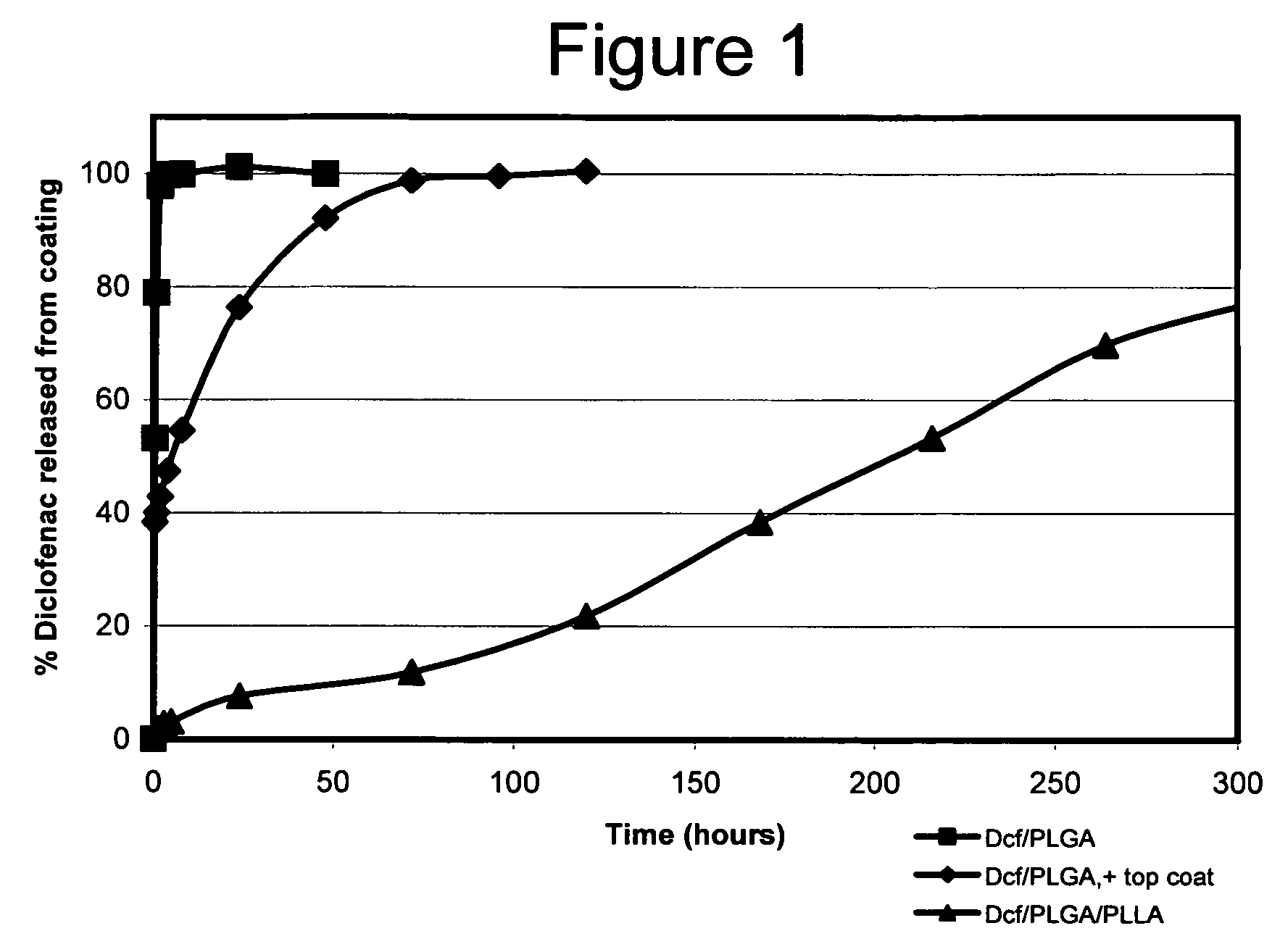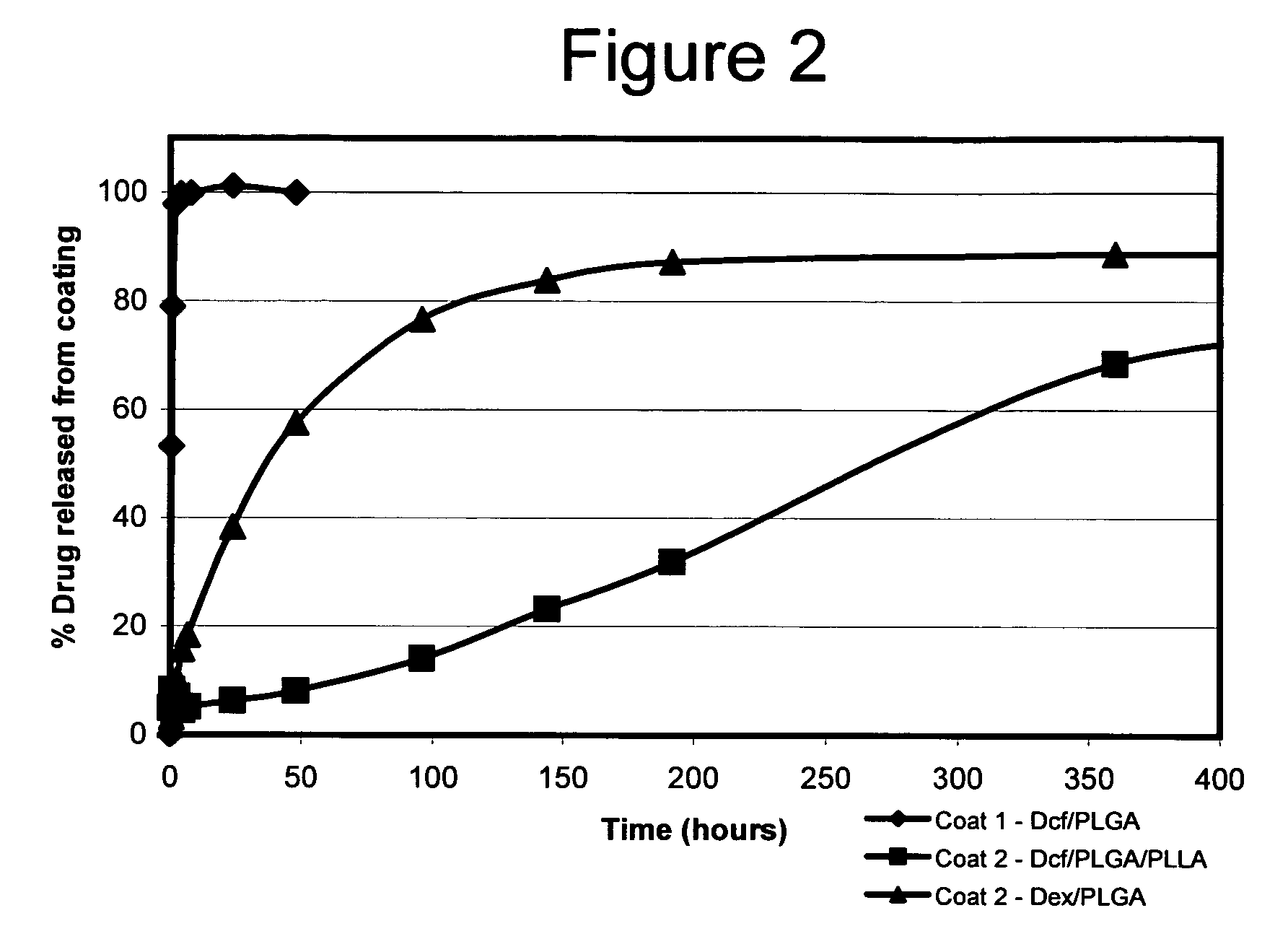Microparticle containing matrices for drug delivery
a technology of microparticles and matrices, applied in the direction of granular delivery, depsipeptides, peptide/protein ingredients, etc., can solve the problems of poor hydrophilic drug release system, poor physical properties of coatings, and inability to release hydrophilic bioactive agents, etc., to reduce the rate of bioactive agent release
- Summary
- Abstract
- Description
- Claims
- Application Information
AI Technical Summary
Benefits of technology
Problems solved by technology
Method used
Image
Examples
example 1
Diclofenac / PLGA Microparticles Immobilized in a Polymer Layer
[0186]Degradable microspheres were prepared containing a hydrophilic, water-soluble anti-inflammatory agent and then immobilized on a substrate surface in a polymeric matrix. The microsphere-coated substrate was then placed in media and the release of the anti-inflammatory agent from the surface of the substrate was quantified over a period of time.
[0187]Poly(lactide-co-glycolide) (PLGA) microspheres loaded with diclofenac were prepared by an oil-in-water emulsion / solvent evaporation technique (Wichert, B. and Rohdewald, P. (1993) J. Microencapsul. 10:195). In a first step, 30 or 100 mg of fine-particulate diclofenac (Aldrich, St. Louis, Mo.) were combined with 100 mg of PLGA (50:50 lactide:glycolide; average MW 50,000-75,000 daltons; Aldrich, St. Louis, Mo.) dissolved in 15 ml of dichloromethane. The mixture was homogenized at Speed 20 using a Tissue Tearor (Biospec Products; Bartlesville, Okla.) for 1.0 minute. The emuls...
example 2
Diclofenac / PLGA Microparticles Immobilized in a Polymer Layer with an Additional Polymer Topcoat
[0190]Degradable microspheres were prepared containing a hydrophilic, water-soluble anti-inflammatory agent and then immobilized on a substrate surface in a polymeric matrix. An additional polymer topcoat was added after the microsphere / polymer layer. The microsphere-coated substrate was then placed in media and the release of the anti-inflammatory agent from the surface of the substrate was quantified over a period of time.
[0191]Poly(Lactide-co-Glycolide) (PLGA) microspheres Loaded with diclofenac were prepared similar to the method described in Example 1. In a first step, 11 mg of fine-particulate diclofenac (Aldrich, St. Louis, Mo.) was dissolved in 100 ul of acetic acid and 200 ul of dichloromethane. A second solution was prepared containing 110 mg of PLGA (50:50 lactide:glycolide; average MW 50,000-75,000 daltons; Aldrich, St. Louis, Mo.) dissolved in 1.0 ml of dichloromethane. The t...
example 3
Double-Walled Diclofenac Microparticles in Polymer Coating
[0195]Degradable microspheres having a double-layer of biodegradable polymers were prepared containing a hydrophilic, water-soluble anti-inflammatory agent and then immobilized on a substrate surface in a polymeric matrix. The microsphere-coated substrate was then placed in media and the release of the anti-inflammatory agent from the surface of the substrate was quantified over a period of time.
[0196]Poly(lactide-co-glycolide) (PLGA): poly-L-lactide (PLLA) double-walled microspheres loaded with diclofenac were prepared as follows. A solution of PLLA was prepared by dissolving 300 mg of PLLA (Aldrich, St. Louis, Mo.) in 1.0 ml dichloromethane. A second solution was made by dissolving 150 mg PLGA (50:50 lactide:glycolide; average MW 50,000-75,000 daltons; Aldrich, St. Louis, Mo.) in 0.8 ml dichloromethane; 50 mg of fine-particulate diclofenac (Aldrich, St. Louis, Mo.) was then added to the PLGA solution. The two solutions were...
PUM
| Property | Measurement | Unit |
|---|---|---|
| molecular weight | aaaaa | aaaaa |
| size | aaaaa | aaaaa |
| molecular weight | aaaaa | aaaaa |
Abstract
Description
Claims
Application Information
 Login to View More
Login to View More - R&D
- Intellectual Property
- Life Sciences
- Materials
- Tech Scout
- Unparalleled Data Quality
- Higher Quality Content
- 60% Fewer Hallucinations
Browse by: Latest US Patents, China's latest patents, Technical Efficacy Thesaurus, Application Domain, Technology Topic, Popular Technical Reports.
© 2025 PatSnap. All rights reserved.Legal|Privacy policy|Modern Slavery Act Transparency Statement|Sitemap|About US| Contact US: help@patsnap.com


